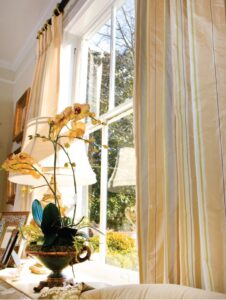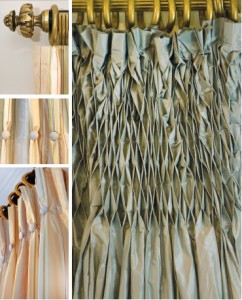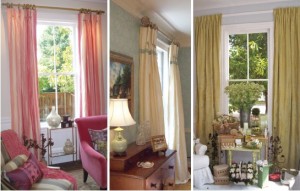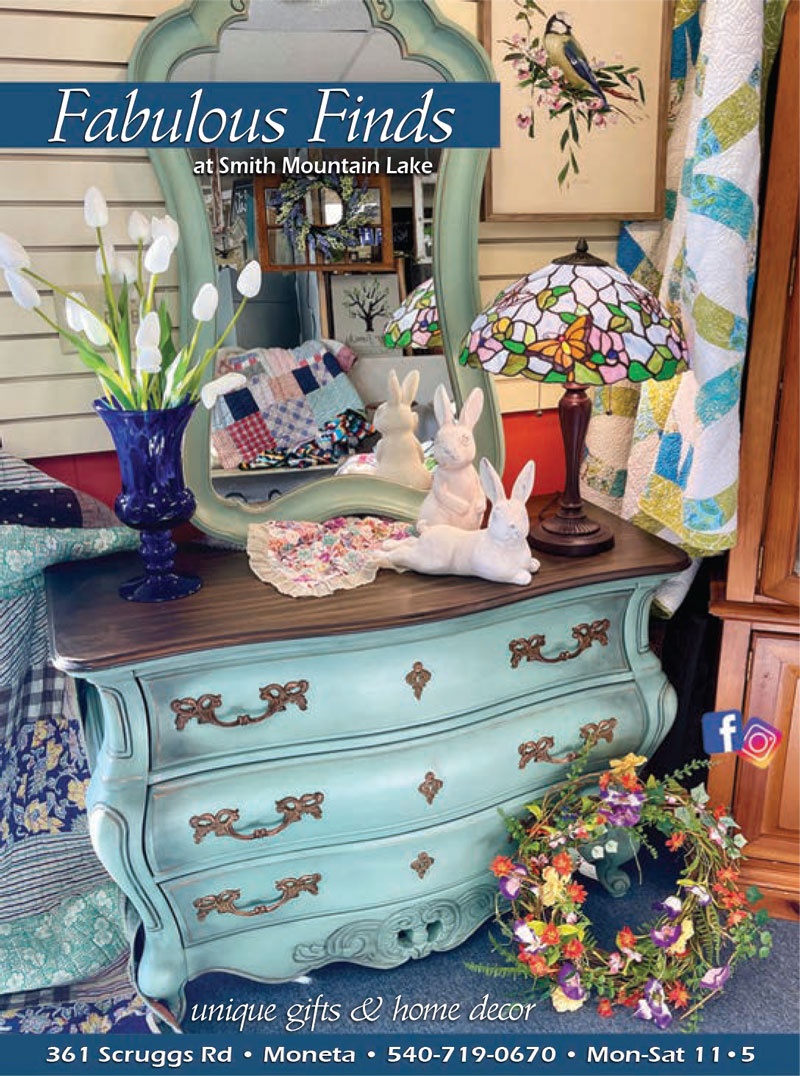Dress your windows with drapery panels
 We needed some pizzazz—and some privacy—in our urban Colonial-style home. And although this was well before HOME, I knew enough to hire a professional. I did not, however, know enough to stop her from designing elaborately swagged and swooped, pinched and pulled custom-fit concoctions that cost more than a small car. When it came time to sell the house and move to our beloved state of Virginia, we sheepishly wrote on the contract: “Window Treatments Convey.”
We needed some pizzazz—and some privacy—in our urban Colonial-style home. And although this was well before HOME, I knew enough to hire a professional. I did not, however, know enough to stop her from designing elaborately swagged and swooped, pinched and pulled custom-fit concoctions that cost more than a small car. When it came time to sell the house and move to our beloved state of Virginia, we sheepishly wrote on the contract: “Window Treatments Convey.”
Live and learn: while some may prefer a one-of-a-kind custom fit, the free-flowing fabric panel is arguably the most classic, versatile option to dress a window. Elegant, adaptable,a nd indeed portable, the drapery panel is a failsafe method to add panache to any room. If I had gone this route, I would not have had to leave behind umpteen custom valances and shades designed for non-standard windows. Whether relocating or
staying put, consider dressing your windows with this design staple. Just think: classic panels can be used in another home, another room, or even amended in their current spot for a new look without starting from scratch. Hemming, lengthening with a band of velvet, adding trim…truly, the options for designing and redesigning panels are endless.
“Panels add softness to a window,” says Kathy Spark, owner of Accent on Windows, a retail showcase and custom workroom in Roanoke. “They frame the window and add a nice contrast to your furniture and carpets.” She says her customers choose drapery panels more than any other window treatment her business offers.
Kitty Ailstock of Fox Ridge Interiors—the seamstress of choice for Roanoke’s custom fabric and furniture showcase The French Thistle—also lauds the drapery panel as a great solution for today’s homeowners who want something elegant but understated. “People don’t want anything fussy,” says Ailstock. “They want homes they can live in—homes that are not just a showplace.”
Perfectly Pleated
Some experts suggest that the key to transforming a humble length of fabric into a work of art is all in the pleats. There are many kinds of pleats: goblet, Euro, tuxedo, inverted, to name a few. Ailstock stands by the basic pinch pleat, saying that it’s making a “big comeback”—and it’s anything but plain. She explains how easy it is to embellish a simple pleat with “jewelry”—a covered button at the base of a pleat, or a bit of
trim. Spark’s personal favorite is the French pleat; it’s tacked at the top and flows out gently for a “casual elegance,” she says. Most experts agree that silk is the most popular fabric for
window panels, beloved for its beauty and versatility. Ailstock says that silk panels comprise as much as 75 percent of her work. And it’s not just for the formal rooms that many of us don’t even have anymore; homeowners are using silk for almost any room, in less formal applications.
Linen and cotton are always in style, and can be jazzed up with passementerie—embellishments that can add a pop of color, pattern and texture. Spark sometimes likes to add a leading edge—a vertical embellishment along the interior edge of the panel—for visual pop. She also suggests grommeted panels— with metal-reinforced eyelets—for a more modern, clean look.
Craftsmanship is Key
No matter what fabric you choose, experts will tell you that lining and interlining your drapery panels are the most critical components of the design. “Very seldom do I do a drape that I don’t interline,” says Ailstock. While lining the drapes will protect your fabric and present a unified look from the outside of your home, interlining will give your panels the volume and lushness they would not otherwise have, she explains.
Spark also points out that while there are many lovely readymade draperies on the market, they often don’t have the lining and interlining that makes custom drapes stand out. She encourages her clients to go custom “as much as possible.” Spark also suggests that drapery weights sewn into the bottom of the panels are “always a good thing” to help your drapes hang properly.
How to Hang Panels
Panels can make a vast space seem cozy, or give height and depth to a small space, depending upon how they are hung. “I like to take panels up high, just below the crown molding or ceiling,” explains Spark. This gives the room height and makes a bold design statement.
The hardware on which these crafted beauties hang is just as important as the curtains themselves, says Spark. “The rod choice is very important because it’s the finishing touch,” she says. Today’s hardware options are vast—
Old World, modern, country French, traditional, and in a variety of sizes and finishes with various finials to finish things off.
Here, too, scale comes into play. A tiny rod with non-descript rings may not work with full, ceiling-height drapes, while a generous 3-inch rod might overwhelm a daintier application. This is where a
professional can really help you strike the right balance.
Spark explains that it is also very important to know before you design your panels if you want or need them to be functional—opening and closing them daily for privacy or light control. The right pleat can help your drapes look just as lovely open as they do closed, and you can also incorporate a decorative wand into the design to help you open and close the drapes. If this is too much fluffing and flouncing for you, consider a traverse rod. Today’s traverse rods can be more attractive than they used to be, with unsightly mechanics hidden behind a decorative rod. If privacy is what you seek, a simple soft shade, sheer panel or blind can be hung underneath.
 Measuring
Measuring
There’s much to consider when measuring for window treatments. If you can, let a professional help you get accurate measurements, which will assure the right amount of fabric and the look you ultimately want. For starters, however, it’s helpful to know some measuring basics. To achieve a look worthy of your window, most experts suggest that panels should be at least one-and-a-half widths of your window to get a full, beautiful drape. So if your window is 35 inches wide, you’ll want each finished panel to measure at least 52 1/2 inches wide. If you want more fullness, consider doubling the width of your window and using that measurement.
Length is a matter of personal preference. While all different lengths can look fashionable and current, some clients prefer a luxurious puddle of fabric, while others want the drape to stop just shy of the floor. Much of this depends upon the household (think toddlers, cats) and the room (kitchen nook versus reading room). Spark suggests “a slight break” in the fabric is a good option for a bit of flair.
If window treatments are on your spring to-do list, consider a classic drapery panel using advice from the experts. These delicious swathes of fabric will truly stand the test of time.






